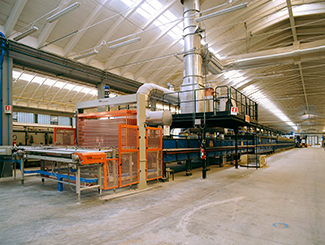 by Andrea Canetti and Andrea Contri24
Novembre
2014
by Andrea Canetti and Andrea Contri24
Novembre
2014
When bureaucracy simplifies business
The Emilia-Romagna Region significantly simplified, by means of Resolution No. 1159/2014, environmental permits parameters for ceramic tiles manufacturers.
If you want and are determined to do it, then you can. After endless stories of ordinary bureaucracy and complicated and incomprehensible procedures and frills, we can finally present a reformed procedure that simplifies regulations though maintaining control and monitoring: the Integrated Environmental Permit, known in Italian as AIA, which will witness bureaucratic relief for the ceramic sector starting January 2015. This major achievement is the outcome of an agreement between Confindustria Ceramica and the relevant Authorities, started in 2012 when the AIAs of the sector were being renewed for the first time.
The rigorous implementation of the IPPC Directive in the region gained the ceramic sector the deserved authoritativeness, guaranteeing highly accurate technical evaluations from Public Administrations, complete authorization acts, full employment of BATs (best available techniques) and MTDs (‘migliori tecniche diponibili’, that is ‘best available techniques’ in Italian) and the creation of an organic system for the acquisition of relevant environmental information (reports).
This has been a five-year-long joint effort that has enhanced the efficiency and accessibility of authorization acts, helping shape them into a clearer and error-free way. Among the changes that have been introduced: simplified documentation and Monitoring and Control Plan, and the removal of what this 5-year plan found unnecessary.
The ceramic sector has proved itself serious and reliable as a dedicated and detailed study presented by the Centro Ceramico of Bologna shows. Thanks to the technology installed and to long consolidated management practices, the performances of the ceramic sector have become of a “structural” nature.
The new regional law welcomes Confindustria’s several proposals: to help reduce compliance for ceramic manufacturers as well as both direct and indirect costs related to the monitoring Plan, and to limit the areas where companies risk criminal prosecution for not observing requirements no longer part of AIA. One of the changes concerns visits from Arpa – the regional agency for the protection of the environment: traditionally taking place every two years, and with costs normally borne by the company, they are now required every three years for those companies not presenting specific critical aspects. The same applies to self-monitoring of several air emissions parameters: controls are not as frequently required as before, and in some cases the number of parameters to check has been lowered. The need for communication regarding abatement equipment shutdowns has been diminished. Company cost savings and a best national administrative practice are expected from such reduced regulation.
Now it is the time existing AIA be adjusted to companies: each company will be able to verify, according to its own AIA, what improvements are best to be introduced according to the forecasts of the new Resolution.
This shows, once again, that with the right will and determination bureaucracy can become a partner for companies without loosing in efficiency or effectiveness.